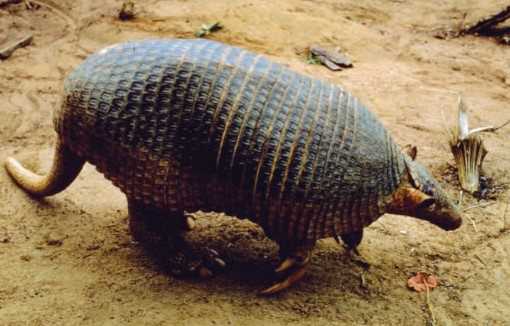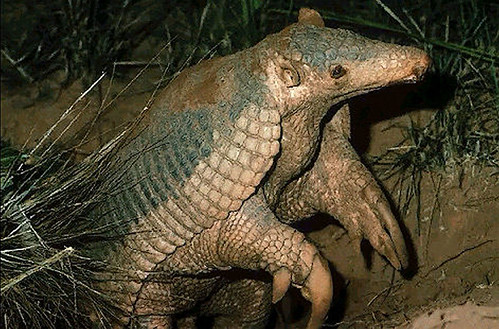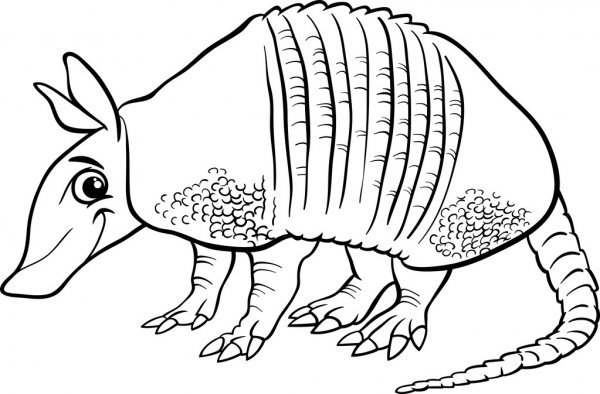
Priodontes maximus: Taxonomy and characteristics, behavior and reproduction, what does it eat? Is it in danger of extinction?
The giant armadillo (Priodontes maximus) has many other names: tatú carreta, gurre grande (Colombia), ocarro, pejichi (Bolivia), cabazú (Brazil), giant cachicamo, cuspa grande, cuspón (Peru and Venezuela), jutinbo (Ecuador).
It is distributed in South America, from Colombia and Venezuela to northern Argentina, being found near bodies of water, in tropical forests, floodplains and savannahs.
It is considered a natural monument of the Argentine provinces of Formosa (1993) and Chaco (1996). However, its population is scarce, and in many parts it has already disappeared or been reduced to its minimum expression.
The giant armadillo is, however, one of the “rarest, cryptic” and least studied species in South America (Aya-Cuero, Superina, Rodríguez-Bolaños 2015).
Characteristics of the giant armadillo
The body is bulky, composed of a flexible shell, made up of small, gray, polygonal plates that are yellowish towards the edges. The limbs are short.
The face is conical in shape, hairless. The head is elongated, the ears are small and widely spaced. On its legs it has large, robust and powerful claws, which can measure up to about 20 cm in the front extremities.
How big is the giant armadillo?
It is the largest armadillo known. It measures, from the snout to the tip of the tail, 1.6 m, and weighs between 28 and 50 kg. Its tail is long, and represents 1/3 to 2/5 parts of the body.
Priodontes maximus taxonomy
It is a mammal of the cingulata order, of the Dasypodidae family. The species has, like the other armadillos of the order, a dorsal shell lined with juxtaposed plates, arranged in transverse rows, with a long tail and short extremities.

Behavior and reproduction of the giant armadillo
The giant armadillo is nocturnal, and is generally found solitary. He has a good sense of smell, although its other senses are poorly developed.
It lives in burrows that it digs in areas not subject to flooding. It usually breeds in the summer season. Their gestation period lasts about four months and it usually gives birth to just one calf or, rarely, two calves.
The mother feeds her young with breast milk for the first four weeks, according to some studies, and up to the first four months according to others. During that period they live in the burrow. They reach sexual maturity by 12 months of life.
What does the giant armadillo eat?
It walks about three km daily in search of food, which is basically insects, ants, termites, earthworms, spiders, maggots, and larvae.
It catches its prey using its tongue, which secretes a viscous substance that sticks to insects. It has about 100 teeth, all the same. It is the land mammal with the largest number of teeth.
Is the giant armadillo in danger of extinction?
Its biggest predator is the human being, who hunts it for its meat, its shell and its nails. Hunting has been so intense that its wild population has been reduced in all South American countries. It has a low reproductive rate and its population is scarce, which threatens the conservation of the species.
It has been considered in danger of extinction since 2002 on the UMC Red List, due to excessive pressure from illegal hunting and the advance of deforestation from plantation crops and other economic activities, such as the exploitation of hydrocarbons.
Its small population, the pressure of hunting, the fragmentation of the habitat, its large size and its reproductive habits (one offspring per birth) conspire against the survival of the species.
Giant Armadillo Drawing

Bibliography
- Abba A.M., Superina M. (2010). The 2009/2010 armadillo Red List assessment. Edentata, 11, 135-184. PDF
- Aya-Cuero C., Superina M., Rodríguez-Bolaños A. (2015). Primeros registros de crías de ocarro (Priodontes maximus Ken 1792) en Colombia. Edentata, 16, 57-64. Source
- Bisbal G. (2019). El armadillo gigante, sus características y distribución. Mis animales.com/ el-armadillo-gigante-sus-caracateristicas-y-distribucion. Source
- Silveira L.A., Jácomo T.A., Furtado M.M., Torres N.M., Soliman R., Vynne C. (2009). Ecology of the giant armadillo (Priodontes maximus) in the grasslands of Central Brazil. Edentata, 8-10, 25-34. Fuente

Dr. Rafael Cartay is a Venezuelan economist, historian, and writer best known for his extensive work in gastronomy, and has received the National Nutrition Award, Gourmand World Cookbook Award, Best Kitchen Dictionary, and The Great Gold Fork. He began his research on the Amazon in 2014 and lived in Iquitos during 2015, where he wrote The Peruvian Amazon Table (2016), the Dictionary of Food and Cuisine of the Amazon Basin (2020), and the online portal delAmazonas.com, of which he is co-founder and main writer. Books by Rafael Cartay can be found on Amazon.com
This post is also available in:
![]() Español (Spanish)
Español (Spanish)
